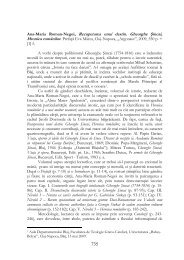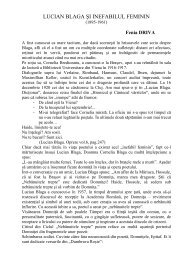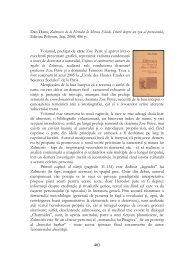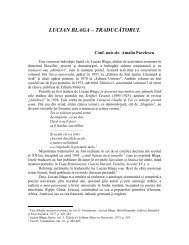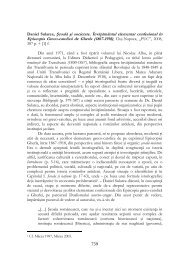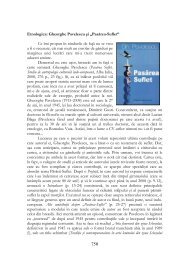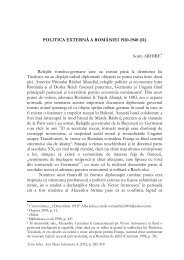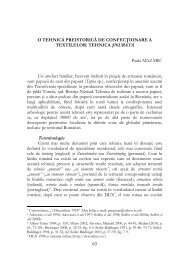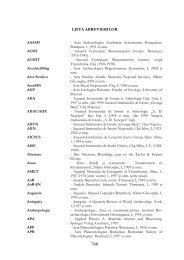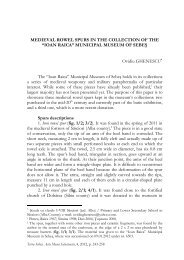Investigaţii avifaunistice în sectorul depresionar al Văii Sebeşului
Investigaţii avifaunistice în sectorul depresionar al Văii Sebeşului
Investigaţii avifaunistice în sectorul depresionar al Văii Sebeşului
Create successful ePaper yourself
Turn your PDF publications into a flip-book with our unique Google optimized e-Paper software.
minor), <strong>al</strong>ături de 76 de specii protejate la nivel internaţion<strong>al</strong>. Dintre acestea,<br />
majoritatea se găsesc şi în zona studiată de noi.<br />
În acest sens se impun măsuri care să reducă presiunea antropică<br />
manifestată mai <strong>al</strong>es prin vânătoare, pescuit, turism şi agrement, respectiv<br />
construcţii şi lucrări agricole şi piscicole. Ca măsuri de protecţie şi ocrotire<br />
se impune corelarea activităţilor economice din zonă cu cerinţele ecologice<br />
actu<strong>al</strong>e <strong>al</strong>e speciilor de păsări.<br />
Avifaunistic Investigations in the Depression Sector of the Sebeş V<strong>al</strong>ley and the<br />
Ponds of the River Secaşul Mare<br />
(Abstract)<br />
The purpose of this paper is to put forth a list of bird species, some of which rare<br />
vulnerable or endangered, from the Sebeş area. At the same time, it aims to present the<br />
status and tendencies manifested in the populations of certain species of prime interest at<br />
European and nation<strong>al</strong> level.<br />
Undoubtedly, a list of endangered bird species cannot be closed. Those in question<br />
are included in the Cartea Roşie a Vertebratelor din România (The Red Book of the Vertebrates<br />
in Romania) which is a list set up in 2005. Some species f<strong>al</strong>l into the broad category of<br />
endangered species at glob<strong>al</strong> level according to norms established by IUCN (Internation<strong>al</strong><br />
Union for Conservation of Nature and Natur<strong>al</strong> Resources). This paper can be regarded an<br />
<strong>al</strong>arm sign<strong>al</strong> drawing attention to the precarious situation of many bird species in our area<br />
and in the country, on the one hand, and the fact that the frail bird population is<br />
maintained largely due to our attitude towards the environment (the Bonn and Bern<br />
Conventions), on the other hand.<br />
The main focus of our research was the wetland and, implicitly, the species living in<br />
a wet environment. These wetlands are situated in the Secaş river meadow, the ponds in<br />
Daia Română and Draşov-Doştat, as well as Lake Petreşti. The sum tot<strong>al</strong> of wetland areas<br />
from the environs of Sebeş does not exceed 300 hectares water surface area.<br />
The ornitologic<strong>al</strong> data were synthesised in a table and cover the time span 1994-<br />
2010. The list comprises 200 species, out of which 108 are brooding and 92 non-brooding.<br />
At the same time, 93 of them live in a strict connection with a water environment. It can be<br />
thus concluded that man-made water basins are of utmost importance. When lakes freeze<br />
many wild ducks, and sometimes even swans, take refuge on Lake Petreşti that does not<br />
freeze completely during winter.<br />
Certain species, i.e. swans, cranes, egrets, black storks, loons, cormorants, herons,<br />
some species of m<strong>al</strong>lard, white-fronted geese, shelducks, shorebird species, gulls, pied<br />
avocets, black-winged stilts or reed passerine birds are new, rare or chance encounters in<br />
our area, a fact little known to both the larger public and the loc<strong>al</strong>s. Considering the fact<br />
that they represent criteria in the selection of certain protected areas in Romania (Natura<br />
2000 sites), a profound knowledge of these bird species is needed.<br />
It is necessary that measures be taken to reduce anthropic pressure exerted<br />
particularly through hunting, fishing, tourism and leisure activities, as well as construction<br />
work, agricultur<strong>al</strong> and piscicultur<strong>al</strong> activities. As protective measure, an adaptation of the<br />
715



